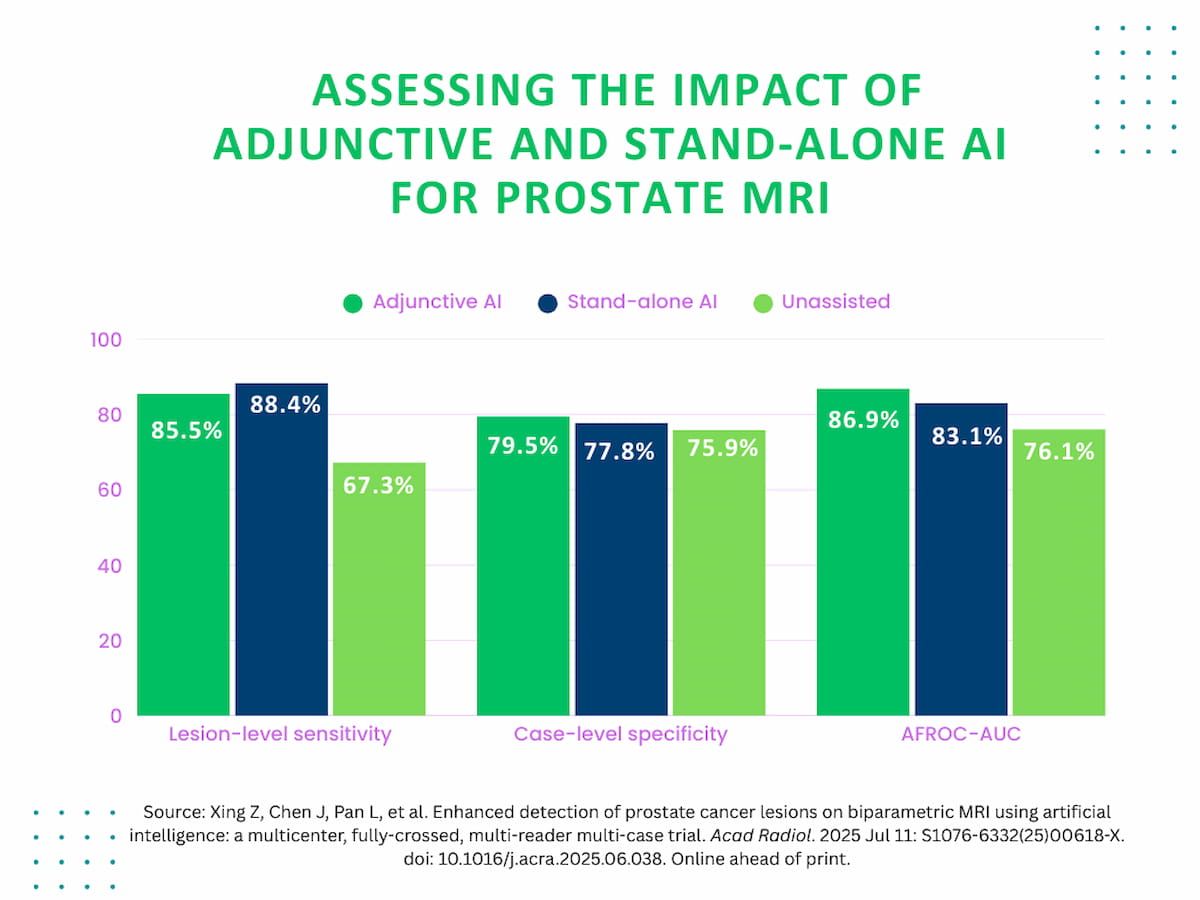Adjunctive and stand-alone use of artificial intelligence (AI) both offered significantly enhanced lesion-level sensitivity for magnetic resonance imaging (MRI) detection of prostate cancer (PCa) in comparison to unassisted radiologist interpretation, according to a new study.
For the multi-readers, multi-case (MRMC) study, recently published in Academic Radiology, the researchers assessed the use a deep learning model (uAI-prostateMR, United Imaging Intelligence) that was trained on 1,688 biparametric prostate MRI sequences. The cohort was comprised of 407 patients (mean age of 69.5) and 10 radiologists with an average three years of experience participated in the study.
The study authors found that adjunctive AI provided an 85.5 percent lesion-level sensitivity for PCa in contrast to 67.3 percent for unassisted radiologist review.
In a study that compared adjunctive AI, stand-alone AI and unassisted radiologist interpretation of biparametric prostate MRI scans for prostate cancer detection, researchers found that adjunctive and stand-alone AI both offered greater than 18 percent higher lesion-level sensitivity than radiologist interpretation.
In addition to slightly higher specificity (79.5 percent vs. 75.9 percent), adjunctive AI provided a 10.8 percent higher area under the alternative free-response receiver operating characteristic curve (AFROC-AUC) in comparison to unassisted radiologist interpretation (86.9 percent vs. 76.1 percent).
“The MRMC study provides robust evidence supporting the clinical utility of the AI system, enhancing its application for PCa detection and localization on biparametric prostate MRI,” wrote lead study author Zhaoyu Xing, M.D., who is affiliated with the Department of Urology at the Third Affiliated Hospital of Saachow University in Jiangsu, China, and colleagues.
The researchers also noted that stand-alone use of AI led to an overall 88.4 percent lesion-level sensitivity, a 77.8 percent case specificity and an 83.1 percent AFROC-AUC.
The greatest differences between deep learning model use and unassisted radiologist interpretation appeared to occur with the detection of small prostate cancer lesions. For PCa lesions < 1 cm in diameter, stand-alone AI offered an 82.6 percent lesion-level sensitivity, adjunctive AI had a 74.3 percent sensitivity and radiologists without the use of AI had a 38.3 percent sensitivity.
Three Key Takeaways
- Adjunctive AI significantly boosts sensitivity. The addition of AI assistance to radiologist interpretation improved lesion-level sensitivity for prostate cancer (PCa) detection from 67.3 percent to 85.5 percent, with a modest gain in specificity and diagnostic accuracy (AFROC-AUC).
- AI outperforms radiologists in small lesions. Stand-alone AI achieved 82.6 percent sensitivity and adjunctive AI provided 74.3 percent sensitivity for detecting PCa lesions smaller than 1 cm in comparison to 38.3 percent sensitivity for unassisted radiologists, indicating this AI platform’s particular strength in detecting small lesions.
- Clinical utility supported despite study limitations. The study supports AI’s role in enhancing PCa detection and localization on biparametric prostate MRI, though findings are tempered by limitations like a controlled reading environment, limited MRI vendor diversity, and lack of clinical data access for readers.
For PCa lesions > 3 cm, there was a 6.6 percent difference in lesion-level sensitivity between adjunctive AI (97 percent) and unassisted interpretation (90.4 percent), according to the researchers.
“These results suggest that the AI system primarily enhanced the diagnosis and localization of smaller PCa lesions,” pointed out Xing and colleagues.
(Editor’s note: For related content, see “Multinational Study Reaffirms Value of Adjunctive AI for Prostate MRI,” “Study: AI-Generated ADC Maps from MRI More than Double Specificity in Prostate Cancer Detection” and “Study: MRI-Based AI Enhances Detection of Seminal Vesicle Invasion in Prostate Cancer.”)
In regard to study limitations, the authors acknowledged the use of a controlled online reading environment, a lack of access to clinical data for the reviewing radiologists, and that one MRI vendor was utilized for over 90 percent of the MRI exams.
